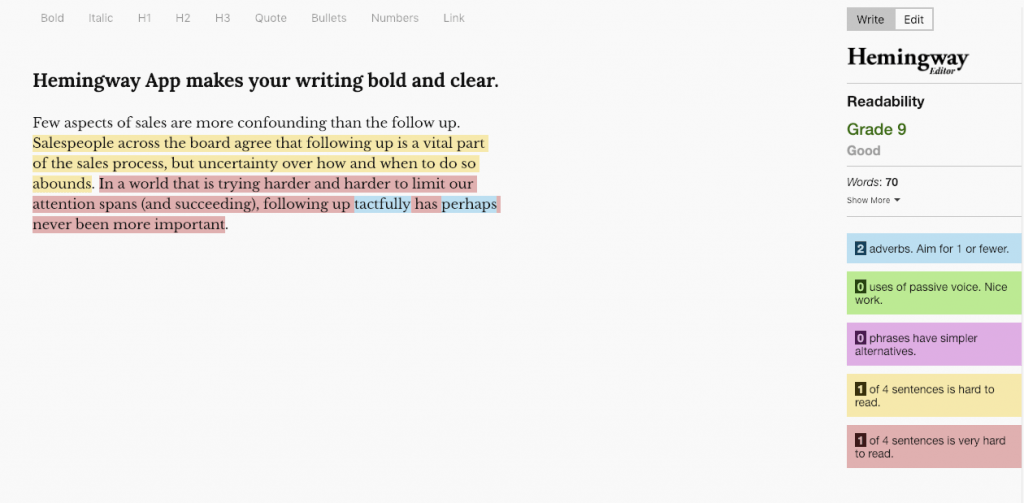Key takeaway
- Following up with leads after making initial contact can prove to be one of the most challenging aspects of working in sales, but by staying organized, being a good listener, keeping it simple, having a plan, and providing value, you’re well on your way to nailing the follow up.
Few aspects of sales are more confounding than the follow up. Salespeople across the board agree that following up is a vital part of the sales process, but uncertainty over how and when to do so abounds. In a world that is trying harder and harder to limit our attention spans (and succeeding), following up has never been more important.
Despite all this, nobody—including salespeople—wants to be perceived as annoying, and there is a point at which you can over communicate and drive leads away.
I talked to a few TechnologyAdvice salespeople in addition to rounding up some sales guidance from thought leaders such as Jill Konrath and John Barrows. Here are some of their thoughts on bad sales practices.
1. Nobody likes being ghosted
The mistake: Not actually following up
Ironically, one of the biggest follow up mistakes you can make as a salesperson is simply not doing it. Regardless of the reason for not following up, this is a mistake. Only 23 percent of sales emails are ever opened, according to TOPO, and even the people who do open your emails are likely to forget to respond to you right away. Prospects lead busy lives just like everyone else. Why should you expect them to do your job for you?
How to fix It: Follow up
In order to cut through the noise, it is imperative to follow up with a prospect after making initial contact. Google rolled out Nudges to Gmail last year, and Microsoft gives you the ability to set follow up reminders for yourself in Outlook.
In an interview with Tenfold, project manager Elizabeth McLeod of McLeod & More said, “It’s easy to miss [following up] when you have a lot of leads or you’re overwhelmed with new accounts. If you don’t have a CRM system, create one for yourself that keeps you accountable for consistent follow-up.”
Action step: An easy, low-tech solution for keeping track of follow ups is a trusty spreadsheet. Whether you use Microsoft Excel, Google Sheets, or Apple Numbers, create a new spreadsheet with columns for date, contact name, preferred method of communication, follow up date, status, and additional notes. You should have something like this:

2. Communicate the right way
The mistake: Following up with people (but not in the way they prefer)
Sending a follow up message or making a phone call is preferable to radio silence, but if you are contacting a client via a method they don’t like, you are also harming yourself. Ignoring or forgetting to ask about a client’s preferred method of communication sends a signal to the client that your only goal is making a sale. To a prospect, this makes them feel as though they are only a number to the salesperson and that their needs and preferences do not matter.
How to fix It: Confirm a prospect’s preferred method of communication
Before finishing your discovery call, ask the prospect what their preferred follow up method is. You may have talked with them on the phone the first time, but email might suffice for future communication. The key here is listening.
Also Read: The Best of Both Worlds: How to Achieve Personalized Sales Outreach at Scale
In a blog post on Sales Hacker, sales coach John Barrows said, “I literally ask people– ‘what is your preferred form of communication moving forward here? Is it cell, e-mail, text?’ I usually get ‘e-mail’ as the answer.” John goes on to provide advice about writing effective subject lines, but the most important takeaway here is being considerate enough to ask people how they prefer to communicate.
Action Step: During your next discovery call with a lead, take a few seconds at the end of the call to determine when you’ll talk again and how. Ask them what follow up method they prefer and confirm their contact information before getting off the phone.
3. Brevity is the soul of landing the sale
The mistake: Not getting to the point fast enough
As critical as it is to take the first step by following up, it’s equally important to do so concisely. Emails can easily grow out of control, and most prospects are too busy to read a 100-word email that should have been 50 words. Lengthy emails also take at least twice as long to write as they do to read. This means you’re not only wasting someone else’s time — you’re also wasting your time.
How to fix It: Spit it out
Perhaps Shakespeare said it best: “Brevity is the soul of wit.”
Mary Houston Coker, a sales executive at TechnologyAdvice, translates this concept to business terms. Mary Houston says, “Try to keep it as short and sweet as possible. I like to give specific days for another time to speak by using a tool like Assistant.to to insert times I’m available. Making it easy for the prospect is ideal.”
Action Step 1: Use a writing app like Hemingway to tidy up your writing. The app highlights difficult sentences and gives you a readability score. Here’s what it looks like using the opening paragraph of an earlier draft of this article.

Action Step 2: Ditch formalities such as “I hope this email finds you well” and “I hope you’re having a good day so far” and start with why you’re writing. Unless it’s absolutely necessary, your email should only be three paragraphs long, and only one of those “paragraphs” should be longer than one sentence.
4. Structure is key
The mistake: Not outlining next steps
Being a salesperson requires thinking on your feet. Many salespeople take this to mean they should constantly be looking for strategic ways to persuade a prospect to commit to a purchasing decision when they should be focused more on keeping the conversation going until a client is ready to commit.
How to fix it: Outline next steps
Have a next step planned out for each interaction during the sales process. Shelby Bruce, sales executive at TechnologyAdvice, says, “Always, always, always set a next meeting time or next step with your prospect before finishing the interaction. Putting a next step on their radar helps decrease the chance that you’ll be ghosted and helps gauge the prospect’s level of interest. If you’ve sparked enough interest and proposed enough value, they’ll continue the conversation.”
Action Step 1: At the end of each step of the sales process, inform your prospect of the next step and get a commitment from them for another call.
Action Step 2: If you are reaching out for the first time, it’s not a bad idea to send the prospect a calendar invitation to a time of your choosing. This makes it easy for them to commit. If that time doesn’t work, they can suggest a new time.
5. Communication should always have something to offer
The mistake: “Touching base”
Everyone has received a follow up email from a salesperson who “just wanted to touch base,” and everyone has reflexively deleted that email. Similar phrases include “just checking in,” “circling back around,” and “just following up.” This is annoying at best, and the only action it inspires is a groan or an eye-roll. These phrases aren’t only meaningless — they’re worthless.
How to fix It: Only communicate when you can add value
Instead of sending another email like this, strive to deliver value. Is there a blog post or white paper from your website that could help answer a question that stumped you during your last interaction? Sending this to the prospect is not only a smart sales move — it shows them that you are genuinely interested in being helpful.
Jill Konrath says, “You need to focus on [the prospect], not you. Don’t wait for them to come begging for your services. Help them. Show them the next steps. Now.”
Action Steps: Review your notes from the most recent call you had with a client. Are there additional resources you could send them to help clarify a process or explain how a product works? Email it to them or give them a call.
Just as salespeople don’t want to be considered nuisances or be rejected, prospects don’t want to waste their time or be pestered. Following up with leads after making initial contact can prove to be one of the most challenging aspects of working in sales, but by staying organized, being a good listener, keeping it simple, having a plan, and providing value, you’re well on your way to nailing the follow up.
Looking for the latest in CRM solutions? Check out our CRM Software Buyer’s Guide.
